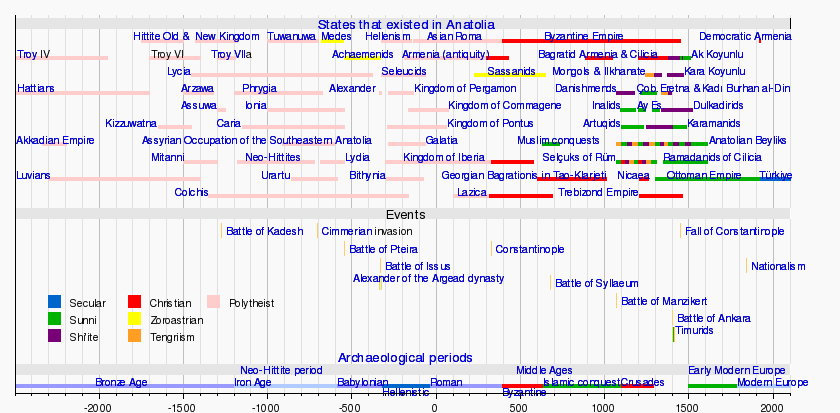Prehistoric Armenia
The modern territory of Armenia has been settled by human groups from the Lower Paleolithic to modern days. The first human traces are supported by the presence of Acheulean tools, generally close to the obsidian outcrops more than 1 million years ago.[1] Middle and Upper Paleolithic settlements have also been identified such as at the Hovk 1 cave.[2] The Armenian Highland finally shows traces of settlement from the Neolithic era. The Shulaveri-Shomu culture of the central Transcaucasus region is one of the earliest known prehistoric culture in the area, carbon-dated to roughly 6000 - 4000 BC. Another early culture in the area is the Kura-Araxes culture, assigned to the period of ca. 3300 - 2000 BC, succeeded by the Trialeti culture (ca. 3000 - 1500 BC).
Excavation campaigns
Revue archéologique issued a report by M. de Morgan, on his excavations, and says:
I have carefully explored the prehistoric necropoli of the mountains of Russian Armenia especially those situated in the forests of the Lelwar, near the well known copper mines in the countries of Akthala, Allahverdi, Tehamlouq, Privolnick, etc. By examining with care the neighborhood of the copper iron made its first appearance in these regions but my excavations proved bronze industry, I have discovered only tombs with iron weapons[3]
Paleolithic
The most recent and important excavation is at Nor Geghi 1 stone age site in Hrazdan river valley. Thousands of 325.000 year old artifacts showed that human technological innovation occurred intermittently throughout the Old World, rather than spreading from a single point of origin (usually hypothesized as Africa), as previously thought. [4]
Neolithic
In Ararat plain the sites of Aknashen and Aratashen are known to belong to Neolithic period.[5]
Bronze Age
The main object of early Assyrian incursions into Armenia was to obtain metals. The iron-working age followed that of bronze everywhere, opening a new epoch of human progress. Its influence is noticeable in Armenia, and the transition period is well marked. Tombs whose metal contents are all of bronze are of an older epoch. In most of the cemeteries explored, both bronze and iron furniture were found, indicating the gradual advance into the Iron Age.
Iron Age
See also
- Armenian hypothesis
- Hayasa-Azzi
- Hayk
- Karahunj
- Mount Ararat
- Nairi (people)
- Prehistoric Asia
- Prehistory of Anatolia
- Prehistoric Georgia
References
- ↑ Dolukhanov, Pavel; Aslanian, Stepan; Kolpakov, Evgeny; Belyaeva, Elena (2004). "Prehistoric Sites in Northern Armenia". Antiquity 78 (301).
- ↑ Pinhasi, R.; Gasparian, B.; Wilkinson, K.; Bailey, R.; Bar-Oz, G.; Bruch, A.; Chataigner, C. (2008). "Hovk 1 and the Middle and Upper Paleolithic of Armenia: a preliminary framework". Journal of Human Evolution 55 (5): 803–816. doi:10.1016/j.jhevol.2008.04.005.
- ↑ American Journal of Archaeology - Page 523 by Archaeological Institute of America
- ↑ 325,000 Year Old Stone Age Site In Armenia Leads To Human Technology Rethink
- ↑ The earliest finds of cultivated plants in Armenia: evidencefrom charred remains and crop processing residues in pise´from the Neolithic settlements of Aratashen and Aknashen, Roman Hovsepyan, George Wilcox, 2008
- ↑ “Armenians” in Encyclopedia of Indo-European Culture or EIEC, edited by J. P. Mallory and Douglas Q. Adams, published in 1997 by Fitzroy Dearborn.
External links
- Prehistoric Sites in Northern Armenia
- World archaeologists have an avid interest in prehistoric Armenia
| ||||||
| ||||||||||||||||||||||||||||||||||||||||||||||||||||||||||||||||||||||||||||||||||||||||

